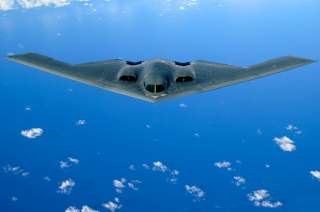What We Know: Russia Has a New Drone That Looks Like a B-2 Bomber.
How deadly is it?
Hunter-B could begin flight-testing any time now, if it hasn’t already done so. “the Russian defense establishment is promising a test that will include a short-duration 'jump'—the UCAV will rise ever so briefly above the tarmac to test its launching and landing capabilities," said Samuel Bendett, an independent expert on the Russian military.
Commercial satellite imagery confirmed the Hunter-B drone’s presence at the 929th Chkalov State Flight-Test Center in Russia's Astrakhan region.
It was the unmanned aerial vehicle’s first appearance since January 2019, when photos began circulating depicting the large, flying-wing UAV on the ground at an airfield in Novosibirsk in southern Russia.
This first appeared in May 2019.
Other warplane types also were on the flight line at the test center, including the Yak-130 trainer and several version of the Su-30 multi-role fighter. But Putin visited Chkalov apparently mostly to hype to Su-57 stealth fighter.
Six Sukhoi Su-57s -- fully half of the stealth fighters that Sukhoi has built since the type first flew in 2010 -- escorted Putin’s Il-96 VIP plane on the trip from Moscow to Astrakhan.
Claiming that Sukhoi had driven down the cost of an Su-57 by 20 percent, Putin announced the Kremlin by 2027 would buy 76 Su-57s instead of just 16, as Moscow previously planned. “I hope that the adjusted plans will be executed,” Putin said in a prepared statement following the Chkalov visit.
Putin by contrast barely mentioned the Hunter-B. “In addition to the modern and advanced military aircraft and helicopters that were shown to us, unmanned aerial vehicles were presented,” Putin said. “I emphasize that all the activities in preparation for the serial production of this technology were performed on time.”
“Let's get to work,” Putin said.
Observers should not read Putin’s comments to indicate that the Hunter-B is ready for mass production and front-line service. It almost certainly isn’t ready.
It’s worth pointing out that Putin’s announcement of a possible big order for Su-57s also could be premature. But before it can mass-produce Su-57s that the Russian air force actually can use in combat, Sukhoi must complete development of the type’s combat systems, integrate weapons on the planes, expand the assembly line that builds the stealth fighters and train workers actually to make them.
A flying wing similar in shape to the U.S. Air Force's B-2 stealth bomber, Hunter-B, in theory, could penetrate enemy defenses to deliver ordnance.
Hunter-B is in the same class as China's Tian Ying drone, the U.S. Air Force's RQ-170 surveillance unmanned aerial vehicle, the U.S. Navy's experimental X-47B UAV and Boeing's X-45C drone demonstrator.
The likelihood of Hunter-B eventually entering squadron service with the Russian air force is "big," Tom Cooper, an independent expert on Russian military aviation, told The National Interest.
"The Russian military is running multiple UAV-related projects," Cooper said. "Thus the emergence of this project is perfectly normal."
Hunter-B could begin flight-testing any time now, if it hasn’t already done so. “the Russian defense establishment is promising a test that will include a short-duration 'jump'—the UCAV will rise ever so briefly above the tarmac to test its launching and landing capabilities," said Samuel Bendett, an independent expert on the Russian military.
"At this point, it is going to be heaviest and fastest UAV [in Russian service] if and when fielded, but additional testing and evaluation will have to take place in order for this unmanned system to be fully functional,” Bendett added. “Its speed [up to 620 miles per hour] and weight — up to 20 tons — means that a host of aerodynamic, electronic and high-tech issues need to be worked out."
To be effective in service, Hunter-B also will need small precision-guided munitions, Cooper pointed out. The Kremlin long has lagged behind the rest of the word in PGM development.
All the above means that Hunter-B might need several more years of development before it's ready for squadron service.
But Russian crews are already getting ready, Cooper said. "The first generation of pilots and ground crews for UAVs just completed their four-years-long training, and they meanwhile have plenty of experience in operating smaller UAVs in Syria."
David Axe serves as Defense Editor of the National Interest. He is the author of the graphic novels War Fix, War Is Boring and Machete Squad.
Image: Wikimedia

